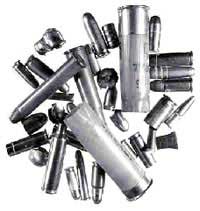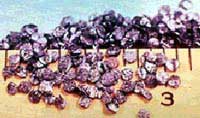|
The Firearms-Toolmarks
Unit receives and examines evidence related to firearms, firearm
components, ammunition, ammunition components, tools, and toolmarks.
Evidence in a typical case may include a number of recovered
rifles, pistols, shotguns, silencers and other muzzle attachments,
magazines, holsters, and a variety of fired and unfired cartridges.
Lead and other metal fragments, shot wads, shot cups, and bullets
removed from bodies at autopsy are also frequently received items
in firearms-related casework. Evidence submitted in toolmark
cases may include screwdrivers, scissors, knives, pliers, wrenches,
crowbars, hammers, saws, wire, sections of sheet metal, chains,
safety-deposit boxes, human bone or cartilage, plates, locks,
doorknobs, bolts, and screens.
Forensic firearms examinations
are based on firearms identification, which involves the identification
of a bullet, cartridge case, or other ammunition component as
having been fired by or in a particular firearm. Firearms examiners
microscopically compare bullets and ammunition components to
each other as well as to any number of firearms to determine
whether an association exists between or among items submitted
as evidence and items whose origins are known. Similarly, forensic
toolmark identifications involve the identification of a toolmark
as having been produced by a particular tool to the exclusion
of all others. Examiners compare the micro- and macroscopic features
of toolmarked items with known and questioned tools that may
have produced them.
Tests and examinations
routinely performed by Unit personnel include
—trigger pull tests,
—function tests,
—full-auto conversion tests,
—accidental discharge tests,
—shot pattern examinations,
—gunshot residue examinations,
—ejection pattern testing,
—trajectory analysis examinations,
—silencer testing, and
—serial number restorations. |
 |
Muzzle flash during
the discharge
of a firearm |
 |
|
Assorted ammunition
evidence |
 |
|
Gunpowder |
 |
|
Trigger pull testing
system |

|
Trajectory analysis
of the bullet
holes in an automobile |
|
|
Firearms examiners
provide field support in FBI investigative matters and administrative
inquiries, directing or assisting with the collection, preservation,
and processing of evidence at crime scenes. In addition, Unit
field teams provide crime scene reconstructions and analyses
as needed, stateside or internationally, with designated response
teams on standby rotation in the event of disaster in the United
States or overseas.
The Unit also serves
as a liaison with national and international forensic laboratories.
Examiners from this Unit provide extensive training services,
both general and specialized, to members of law enforcement agencies
as well as to crime scene personnel and investigators. Training
schools in trajectory analysis, gunshot residue analysis, firearms
identification, and the identification of stolen motor vehicles
are sponsored by the Unit on a yearly basis.
For more information about firearms
evidence or the Firearms-Toolmarks Unit, see the Firearms
Examinations
section of the Handbook
of Forensic Services
and the Firearms
and Toolmarks
article in Forensic
Science Communications.
|

